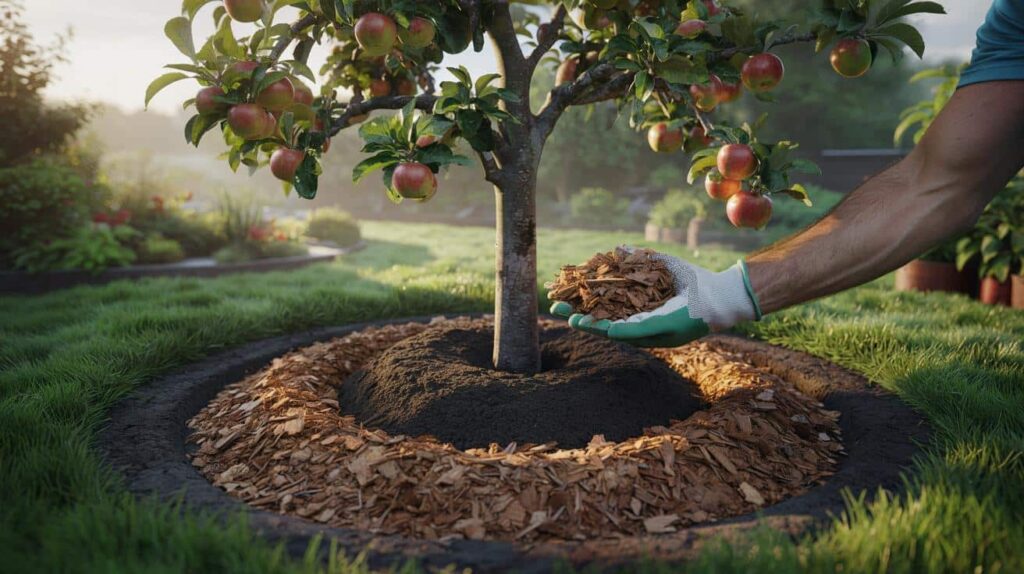You water, you nourish, you trim a bit, and yet the tree still produces marble-sized fruit. The hidden answer lies right there at the base of the trunk, where most of us look last.
It was one of those cool, blue mornings when the street is still and every leaf glistens with droplets of water. My neighbor’s apple tree was laden with fruit, its branches bending like an old ship in a tranquil harbor. He didn’t reach for a spray or a bottle of fertilizer. Instead, he knelt down, cleared away the grass, and uncovered a soft ring of wood chips and dark compost embracing the soil—nothing extravagant, just consistent care where it matters. **The secret rested quietly at the foot of the tree.** We’ve all experienced that moment when something obvious suddenly makes sense. The answer wasn’t in the sky or in a store. It was beneath our feet.
Why the base of the tree determines your harvest
Fruit trees draw nourishment from a network of fine feeder roots that reside close to the surface, often within the top hand-width of soil. Grass and weeds at the base of the trunk consume the same water and nutrients first, depriving the tree of its breakfast. Alter the ground, and the crown transforms along with it.
In a community orchard I visited, volunteers undertook one simple task one spring: they removed the grass in a wide ring and laid down a thick layer of arborist wood chips around each trunk. By autumn, the difference was evident in the crates—fewer scabbed apples, larger pears, and fewer June drops. One older plum tree, which had been stubborn for years, finally produced a generous, steady crop.
There’s a rationale behind it. A mulch ring cools the soil, slows evaporation, and retains the abundance of water and nutrients within reach of the feeder roots. It mitigates summer heat fluctuations that stress blossoms into dropping their fruit. Soil life awakens beneath the chips and compost, releasing nutrients in gentle pulses rather than abrupt spikes.
The simple action at the base: the mulch donut
Here’s the action that transforms everything: carve a clean, grass-free circle around your tree, as wide as the drip line if possible, and lay down a “donut” of mulch. Begin with 2–4 centimeters of mature compost on the soil. Top it with 8–10 centimeters of rough, free arborist wood chips, maintaining a neat gap around the trunk flare. **Create a wide, soft donut of mulch and compost around the drip line, not against the trunk.** Water the ring slowly to allow it to settle.
Common mistakes are minor and easily corrected. Avoid creating a “mulch volcano” against the bark—it retains moisture, invites rot, and suffocates the trunk flare. Skip landscape fabric; it obstructs the vital exchange between soil and air, and roots can become entangled in it. Let’s be honest: nobody performs this task daily. Do it once, then replenish the chips once or twice a year, like topping off a kettle.
There’s a certain satisfaction to it. You step back, the lawn recedes from the trunk, and the tree finally has its own serene circle. It feels a bit like tucking the tree in for a peaceful nap, then walking away feeling lighter. The ring demands almost nothing and rewards you with consistent moisture, cooler roots, and cleaner fruit. When rain falls, it stays. When the sun scorches, it endures. When blooms open, they are less stressed, less likely to drop their fruitlets prematurely.
“Feed the soil and you nourish the tree. Safeguard the roots and the tree safeguards your harvest.” — an old arborist’s principle that remains effective
- Diameter: aim for the drip line; at least 1 meter wide for young trees.
- Depth: 8–10 cm of wood chips; 2–4 cm of compost underneath.
- Trunk gap: maintain a 10–15 cm clearance around the bark flare.
- Timing: any time the ground isn’t frozen; spring and autumn are the easiest.
- Top-ups: add fresh chips when the layer settles to 4–5 cm.
Maintain the circle throughout the seasons
Good harvests often stem from small rituals practiced with patience. Refresh the ring when it sinks, remove sprouts that emerge, and once in spring, sprinkle a handful of slow-release minerals—rock dust or a balanced organic fertilizer—into the compost layer, never on the bark. When dry spells occur, set a hose to a gentle trickle directly on the ring for 45–90 minutes, then walk away and let the soil absorb the moisture peacefully. **Fruit doesn’t arise from fuss; it comes from steady, quiet support.**
| Key Point | Detail | Reader Benefit |
|---|---|---|
| Grass-free mulch ring | Wide donut of compost + wood chips at the drip line | Enhances moisture, nutrients, and root health for larger harvests |
| No contact with trunk | Maintain a 10–15 cm gap around the bark flare | Prevents rot, pests, and stress |
| Seasonal top-ups | Replenish chips when the layer settles | Low-effort maintenance that yields cumulative results |
FAQ :
- How wide should the mulch ring be?The drip line is ideal—the circle beneath the branch tips. For young trees, start at 1 meter and expand each year.
- What type of mulch is best?Fresh arborist wood chips are excellent: a mix of leaves, twigs, and bark nourishes fungi and retains moisture. Shredded bark alone is less effective.
- Will mulch deplete nitrogen from my tree?Not when it rests on top. Nitrogen tie-up occurs when chips are mixed into the soil. Keep them as a blanket, not a mixture.
- Can I use grass clippings or leaves?Yes, in thin layers beneath the chips. Clippings can mat; mix them lightly and cover with wood chips to allow air circulation.
- When will I see results?You’ll notice healthier leaves and more consistent moisture within weeks. Larger fruit and fewer drops typically appear the following season.








